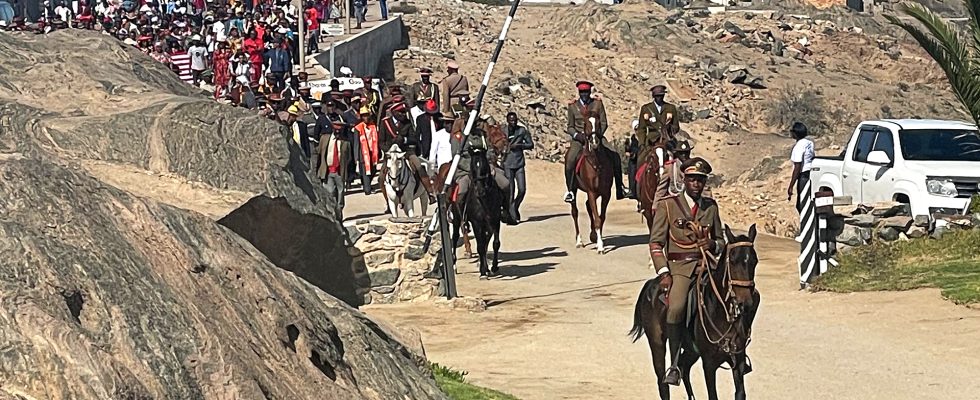Status: 04/23/2023 12:49 p.m
The uprisings against the German colonial rulers were brutally suppressed in German South West Africa. Only now can the descendants of the victims commemorate them. A memorial was unveiled in southern Namibia.
In 1904, the Herero people rose up against the German colonial rulers in what was then known as German South West Africa. When the Germans brutally crushed the uprising, the Nama people followed. Their uprising was also put down. The survivors of both races were crammed into internment camps: men, women and children.
The worst of these camps was located in the south of the so-called protection area – next to the town of Lüderitz. There, people were treated worse than animals. Between 1000 and 3000 people died on the peninsula “Shark Island”, also called the “Island of Death”, the exact number was never known.
Surrounded by the Atlantic
It did not look like a concentration camp as the horrified world would see 40 years later. There were no walls, no barbed wire fences, no gas chambers. “Shark Island” was and is a rough place, strewn with gray rocks, surrounded on three sides by the Atlantic Ocean, where sharks used to live. The people vegetated on the stones, without blankets, without protection from the sun, without protection from the damp cold.
Within six months of their arrival, 80 percent of all inmates were dead. Their bodies were thrown into the water, where sharks ripped them apart. “The angel of death fell on them with brutal force,” says Paul John Isaak, spiritual leader of the Nama. “The survivors looked starved, their bodies reduced to skin and bones. They looked like broomsticks, the bones so thin you could see through them.” Even the German occupiers called these places of hell “concentration camps”.
“Shark Island”: On the gray stones, people were defenseless against the heat and cold.
Image: SWR
They had simply adopted it from the British colonial powers, which a few years earlier had reached the first death camps in neighboring South Africa and called them “concentration camps”.
During the Anglo-Boer War at the end of the 19th and beginning of the 20th century, the British colonial rulers decided to completely wipe out the Boer people, which they did not succeed in doing. Their German neighbors in German South West Africa wanted to do exactly the same with the Herero and the Nama, but they didn’t succeed either.
“Scientific” experiments
Sima Luipert-Goeieman’s great-grandmother was imprisoned on the “Island of Death”. She had to scrape off the skin and hair of killed inmates, including the heads of their family members. The skulls were brought to the Empire, where so-called racial scientists took their measurements.
The aim of this obscure “scientific” activity was to prove that blacks on the African continent were inferior beings, closer to apes than to white Europeans. “They didn’t treat my ancestors like human beings, nor the women and children,” says Sima Luipert-Goeieman.
It was part of the German strategy to terrorize us, to break our will to live. Decades later, a next generation of Germans in Auschwitz and elsewhere would horribly perfect this.
In memory of their suffering, the spirits of the ancestors are invoked.
Image: swr
Germany and the term “genocide”
In 1915 the Germans were driven out of German South West Africa by British and South African troops. First the United Kingdom took over the area, later the South African apartheid government. Namibia only became independent in 1994. And still no one cared about the Herero and the Nama, who were making louder and louder demands. They wanted financial compensation, but above all a coming to terms with their history. Nobody listened.
Finally, in 2002, the German development minister, Heidemarie Wieczorek-Zeul, said for the first time that the events of 1904-1908 constituted genocide. Only in 2015 did the German government officially recognize the genocide, but not in the sense of international law. Under international law, this would have meant that high reparation payments could have been demanded. Instead, the relaunch of a reconciliation initiative was started, in which the German federal government offered 1.1 billion euros spread over 30 years. This initiative had already existed before.
“We never saw any of that money,” say the Herero and Nama. The government, which is dominated by another ethnic group, the Ovambo, took all of this. The ratification of the second reconciliation agreement failed in June 2021 due to resistance from the Herero and the Nama. They demand new negotiations. But Berlin rejects this.
The Herero women attach great importance to their traditional costume. According to researchers, the return to this clothing is also linked to the genocide.
Image: SWR
Memorial stone – and then final line?
The first memorial stone was erected in the Namibian capital of Windhoek just ten years ago. The second memorial stone was unveiled on Shark Island on Saturday. Sima Luipert-Goeieman and Paul John Isaak are relieved. Finally there is also the opportunity here to mourn in one place, to weep for the blood of the dead. But it must go on, the genocide must also be better scientifically processed. And 1.1 billion euros in compensation are not enough. No line should be drawn.
It is doubtful whether they will succeed in their demands. It looks as if the suffering of two humiliated peoples will go on for a long time.

